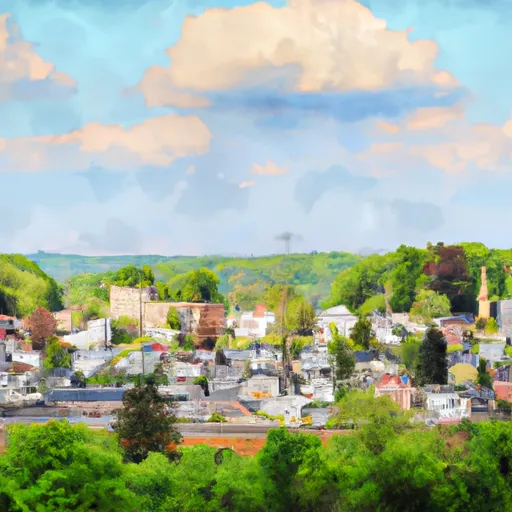-
 Snoflo Premium
Snoflo Premium
Get unlimited access to all our content
With no Ad interruptions! - Start Your Free Trial Login with existing account
Shartlesville
Eden Index
Climate
9.2
•
Recreation
2.8
•
Community
•
Safeguard
4.7/10

Shartlesville, Pennsylvania is a small borough located in Berks County. The climate in Shartlesville is classified as a humid continental climate, characterized by warm summers and cold winters. Average temperatures range from around 25°F (-4°C) in winter to 85°F (29°C) in summer, with moderate precipitation distributed throughout the year.
The hydrology constituents in Shartlesville mainly revolve around the Schuylkill River, which flows nearby. The river provides opportunities for fishing and boating, with species such as trout, bass, and catfish commonly found. Additionally, the area is surrounded by several smaller creeks and streams, enhancing the hydrological diversity.
Outdoor recreation opportunities in Shartlesville are plentiful. The Blue Marsh Lake, located a short distance away, offers activities such as boating, swimming, fishing, and hiking. The nearby Blue Mountain range provides opportunities for hiking, mountain biking, and wildlife observation. The scenic Appalachian Trail, which stretches over 2,000 miles, passes close to Shartlesville, attracting hikers from all over.
Overall, Shartlesville, Pennsylvania, with its pleasant climate, diverse hydrology constituents, and various outdoor recreation opportunities, is a charming destination for those seeking to explore nature and enjoy outdoor activities.
What is the Eden Index?
The Snoflo Eden Index serves as a comprehensive rating system for regions, evaluating their desirability through a holistic assessment of climate health, outdoor recreation opportunities, and natural disaster risk, acknowledging the profound impact of these factors on livability and well-being.
Climate Health Indicator (CHI): 9.2
Shartlesville receives approximately
1290mm of rain per year,
with humidity levels near 76%
and air temperatures averaging around
10°C.
Shartlesville has a plant hardyness factor of
6, meaning
plants and agriculture in this region thrive during a short period during spring and early summer. Most
plants will die off during the colder winter months.
By considering the ideal temperature range, reliable water supplies, clean air, and stable seasonal rain or snowpacks, the Climate Health Indicator (CHI) underscores the significance of a healthy climate as the foundation for quality living.
A healthy climate is paramount for ensuring a high quality of life and livability in a region, fostering both physical well-being and environmental harmony. This can be characterized by ideal temperatures, reliable access to water supplies, clean air, and consistent seasonal rain or snowpacks.
Weather Forecast
Streamflow Conditions
Lower Delaware
Area Rivers
Lower Delaware
Snowpack Depths
Lower Delaware
Reservoir Storage Capacity
Lower Delaware
Groundwater Levels
Recreational Opportunity Index (ROI): 2.8
The Recreational Opportunity Index (ROI) recognizes the value of outdoor recreational options, such as parks, hiking trails, camping sites, and fishing spots, while acknowledging that climate plays a pivotal role in ensuring the comfort and consistency of these experiences.
Access to outdoor recreational opportunities, encompassing activities such as parks, hiking, camping, and fishing, is crucial for overall well-being, and the climate plays a pivotal role in enabling and enhancing these experiences, ensuring that individuals can engage in nature-based activities comfortably and consistently.
Camping Areas
| Campground | Campsites | Reservations | Toilets | Showers | Elevation |
|---|---|---|---|---|---|
| Ricketts Glen State Park | None | 2,254 ft | |||
| Frances Slocum State Park | None | 1,200 ft | |||
| Moon Lake County Park | None | 1,133 ft | |||
| Locust Lake State Park | None | 1,260 ft |
Nearby Ski Areas
Catastrophe Safeguard Index (CSI):
The Catastrophe Safeguard Index (CSI) recognizes that natural disaster risk, encompassing floods, fires, hurricanes, and tornadoes, can drastically affect safety and the overall appeal of an area.
The level of natural disaster risk in a region significantly affects safety and the overall livability, with climate change amplifying these risks by potentially increasing the frequency and intensity of events like floods, fires, hurricanes, and tornadoes, thereby posing substantial challenges to community resilience and well-being.
Community Resilience Indicator (CRI):
The Community Resilience Indicator (CRI) recognizes that education, healthcare, and socioeconomics are crucial to the well-being of a region. The CRI acknowledges the profound impact of these elements on residents' overall quality of life. By evaluating educational resources, healthcare accessibility, and economic inclusivity, the index captures the essential aspects that contribute to a thriving community, fostering resident satisfaction, equity, and social cohesion.

